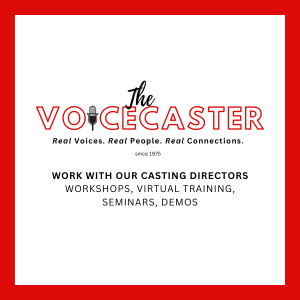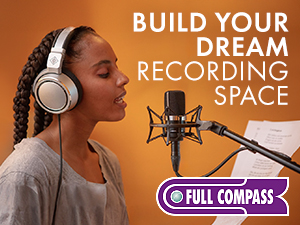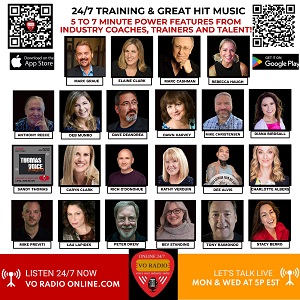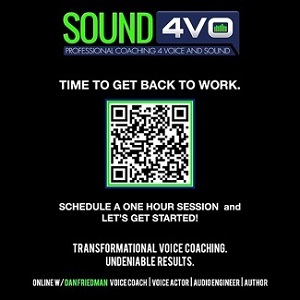|
Interview: Maureen Young / Part 1
Queen of The Sound Picture:
'Listen To Copy For The Story'
By John Florian
©2009 VoiceOverXtra
Young calls herself Queen of The Sound Picture - because, indeed, voice actors create sound pictures in the minds of listeners.
It begins with questions about the copy:
“What are you trying to say here?” Young asks. “What’s really happening? Who’s telling the story? Who’s listening to it? What is the scenario?”
Young’s career has come full circle – from singing jingles at age seven on a Chicago TV kid’s program, to voice acting, singing, and now back to voice acting in New York City.
Along the way, this has included many national commercials – spots for Gillette, Clairol, McDonald’s, Hallmark, Sears – industrial narrations, promos, staged readings, and teaching voice-over privately and at the School for Film and Television in New York.
The following chat with Queen Maureen might forever change the way you approach voice-over copy …
Maureen, I get a sense from your demos, from your style, that you are very much a storyteller.
Thank you. Did you feel that way about all of my demos - narration, telephony, characters - or just with commercials?
With everything - it’s like you’re telling me an interesting story, and I want to talk with you on that. How would you describe your style?
Actually, I do like to reel them into a scenario, come to think of it.
Even with my friends, I like to set the stage when I’m just giving them information.
Life to me is like a series of stories in real time. In life, those stories become chapters in an expanding book.
Yeah, I guess you could characterize me as a story-teller.
So, when you are performing a voice-over, you are really telling your client’s story.
I think two things. You get into the character, and you get into the text, which is the presentation of a story.
For instance, let’s say I’m going to talk about the new three-stack cheeseburger, whatever it is. This is really exciting! They are giving three great burgers for the price of one!
So depending upon the copy, the story here is that if you like to eat that kind of juicy burger, and you like more of a good thing, now is the time to eat it. Less for more, bigger is better, like that.
So the character you create in your mind to express that feeling is really jazzed - the whole thing is just too cool!
You are sounding very convincing …
Well, there is a story embedded in every commercial. And you have little time to set the stage and tell it.
There is always a plot or a scenario.
So, how do you approach the copy? You get the script. And then what goes through your mind - breaking down the copy to find that story?
I think first of all, in voice-over - like anything else - you have to have the raw ability.
Having a distinct sound is just the license to perform.
When I get a script, I study it, and the first thing I think about is the text. What am I listening for? What is it I want the listener to hear?
Then I need to listen to the words - speaking them as thoughts in my mind-speak. In doing that, colors evolve. The scenario takes shape.
Let me give you an example.
Okay.
Let’s take the first commercial on my demo, the one for Snuggles.
Now, you want that kid to sleep, right? And you want that kid to stay asleep - whether it is a princess or any other kid. But if there is a pea under the mattress, you know that it will make the mattress uncomfortable and unlovable.
Think about that: “Gee, if there is something under the mattress, how could we get it out of there so the kid can sleep?”
So I conclude, all things can be made perfect - mom to the rescue.
I don’t know if I consciously think that through for a long time, but that is the story of that commercial. And you definitely want to create sort of a lullaby feeling to it.
I don’t break it down that much consciously, though. The first time I read it, I sort of see the scenario.
I like a more organic read. I like to spontaneously react after I’ve read it to myself and internalize it once or twice.
You’ve mentioned to me that you have coached people in person and by phone. What have been their problems or their concerns, and what did you advise?
I try to get them involved in what they are saying.
What is the text about? What is the copywriter trying to get the listener to do?
Let’s use the voice or the tone of voice that’s appropriate to get that to happen.
Here’s an example. There was a TV ad – I can’t remember the product – but a woman voiced it, and the ending line was something like, “If you turn it on, does it turn you on?”
Well, the voice talent was reading it sort of straight. But I thought, this is about sex, or why would the copy be written that way? So I asked her to put sensuality into the read, to get the point across better.
And we reworked the line to say, “When you turn that motor on, does it turn you on?”
There are other things to consider ...
Yes, it’s also a matter of learning where to pause, learning how to pace.
But overall, I approach coaching by asking them to put it across.
I ask, “Come on, what are you trying to say here? What’s really happening here? Who’s telling the story? Who’s listening to it? What is the scenario? That’s a word I use a lot.
I try to get people really invested in the copy. That’s how we break it down. Because if they are invested, the pauses and the pacing will come quite naturally.
For some folks, it’s a struggle. You have to go through several reads before they can perform with wild and reckless abandon
So you’re saying, “Don’t over-think it. It’s kind of intuitive?
For me it has been that way, yes. But it isn’t that way for everybody. And I think sometimes that people can get too much coaching, or too much input from ”supposed experts.” They wind up getting all locked up.
You mean, just allow yourself to express what you’re feeling.
Yes - what you are feeling when you read that commercial. That’s the end result we want.
Maureen, tell me about your career now. Starting from whenever.
I started voice-over work when I was about seven or eight, working for a network affiliate out of Chicago, which is where I am from, singing the opening jingle for a kid’s program.
I always loved doing kid stuff, always. So, at the age of seven, I did that.
Because I was a precocious kid and probably drove my mother crazy, she took me to a voice lesson.
The singing teacher knew the producer, and the producer heard me sing, and I was such a cute little kid with this voice and tra-la-la-la-la. So I got the job singing that little jingle every week.
And from there?
I kept doing voice work, and actually was working with a lot of older, very well-known men in voice-over in Chicago at that time - Russ Reed, Herb Graham, Harry Elders - a lot of the greats. They were protective of me like a father would be, and they would send me around to various people.
I got an agent who sent me out on a lot of auditions. In those days, you could make the rounds, as they used to call it. You could actually call somebody, get a live person on the phone and make an appointment, walk around, bring in your demo, have a cup of coffee, or sit there and talk to someone about what you like to read.
It wasn’t so insulated and isolated, like today with the Internet. There was more emphasis on human contact.
And you continued as a singer?
Yes, I started in classical music when I was a teenager studying at the American Conservatory of Music in Chicago. Then I went to the University of Illinois for a communications degree, and after that, studied with the late Oran Brown and Beverly Johnson, my singing teachers at Juilliard. I studied classical, but I always loved to sing musical theater stuff. On my own, I memorized all the Broadway songs that I liked. I still do that. Keep that karaoke busy here!
And what’s your career like now?
Well, I’ve come back full circle. I still have musical theater students, some notable ones, in fact. But the economy has hit the singing teacher business hard.
So, I was always very successful in voice-over, having done a lot of network stuff.
I still have the voice, thank God, and can do the reads - so I’m back into voice-over, straddling both worlds.
Maureen, through all of this, you haven’t mentioned that you are blind …
Well, I guess I never think about it much. Other people do. But it is not my focus, you know.
I don’t mind talking about it, but it’s just not my focus, that’s not where I’m at.
To contact Maureen Young:
Email: voicepro4u@verizon.net
|
|
|
Tell Us What YOU Think!
Please Note: Since we check for spam, there will be a slight delay in the actual posting of your comment.
Comments (1)
Christine
12/11/2009 at 8:43 AM
This is a wonderful article. I can't wait for part 2. As a blind person myself I would probably have a lot of questions for Maureen that other people might not think of. We look at VO in similar ways. She is Queen of the Sound Picture and I consider myself to be Vision-voice.








.png)

click for new article alerts